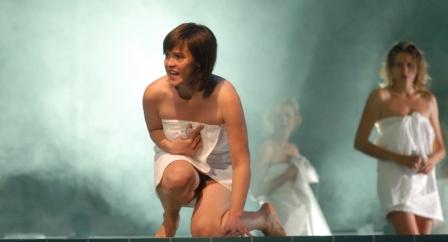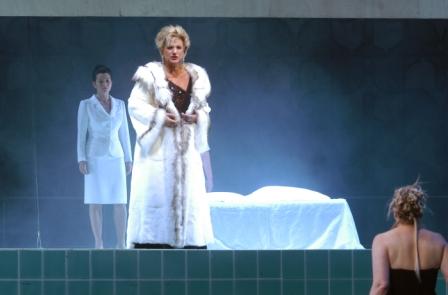|

A New Fascism
'Elektra' at Hungarian State Opera,
reviewed by RODERIC DUNNETT
One thing Richard Strauss's Elektra, Balázs Kovalik's first production as the new Artistic Director of the Hungarian State Opera, confirmed was the glaring talents of János Kovács, from whom Adam Fischer has just taken over as Music Director. Of that, more later.

Balázs Kovalik, the new Artistic Director of the Hungarian State Opera House. Photo © 2007 Vera Éder
|
Kovalik's disconcerting, somewhat sensational (and just occasionally specious) staging, paired with Csaba Antal's ceramic public baths designs, ensured this Elektra [seen 1 December 2007] gripped its audience by the throat. The setting was a luxurious swimming bath, all blue and white tiles: its human contents concealed from view, then revealed by an unpredictable overhead mirror whose shifting focus choreographed the upper stage action like a filmic effect.

The baths of Agamemnon - Eszter Wierdl as a maid in Kovalik's hothouse production of Strauss's 'Elektra'. Photo © 2007 Vera Éder
|
'I felt the setting of the opera must be the bath where Agamemnon was murdered,' Kovalik explained. 'We considered using an Art Nouveau design, directly mimicking the baths in Budapest, which date from around the date the Hoffmanstahl play was written. But we decided against that, preferring a timeless, abstract, stylised version, expressing the idea that the bath is a place to which Elektra feels mesmerisingly drawn, but where she also feels imprisoned.'

Agnes Baltsa as a luxuriant Klytaemnestra, with Nadine Secunde as Elektra. Photo © 2007 Vera Éder
|
This claustrophobic setting, with its eerie links (nonetheless) to the lavish Danube-side Turkish baths of modern day Buda, and abetted by Mari Benedek's monochrome costuming (her designs were likewise a triumph in Kovalik's watery staging of The Turn of the Screw) was the sinister playpen of Agnes Baltsa's regal, cat-like Klytaemnestra: a stupendous rich bitch, descending on her bed from the rafters, replete with fairyland riches, she appears like some ghastly amoralistic Juno, plying her new-fangled push-button contraptions with hauteur and disdain.
Continue >>
Copyright © 13 March 2008
Roderic Dunnett, Coventry UK

|

